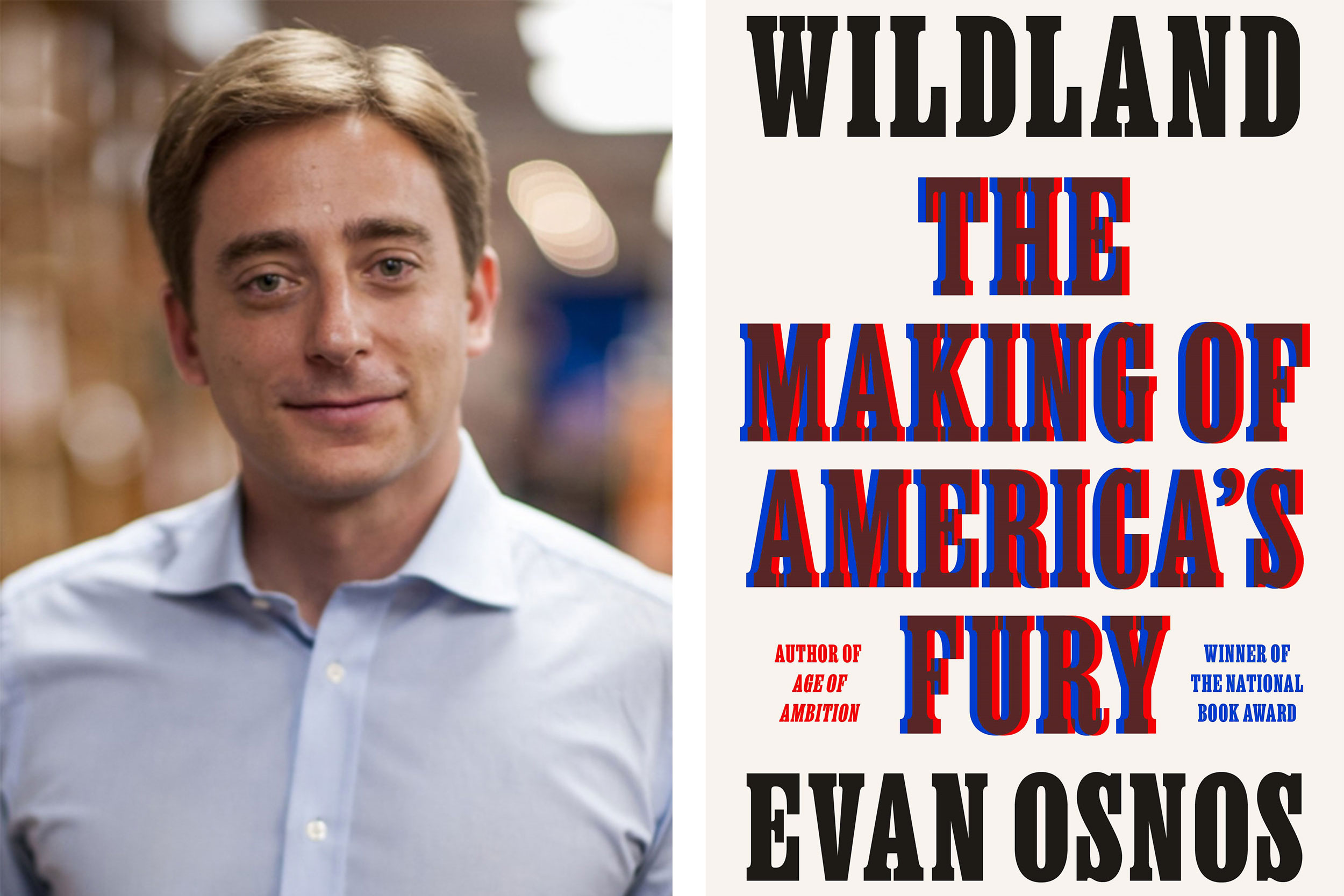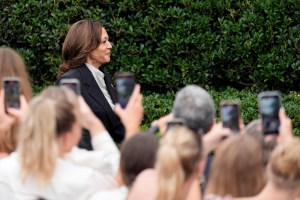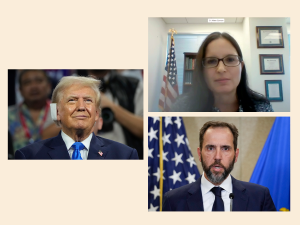
“This book is the story of a crucible, a period bounded by two assaults on the country’s sense of itself: the attack on New York and Washington, on September 11, 2001, and the attack on the U.S. Capitol, on January 6, 2021,” writes Evan Osnos ’98.
Photo by Peter Marovich ©
Political spark that ignited firestorm across dry, divided land
After decade away, Evan Osnos writes about transformation in U.S. between 9/11 and Capitol attack
Excerpted from “Wildland: The Making of America’s Fury” by Evan Osnos ’98, staff writer at The New Yorker, published by Farrar, Straus and Giroux.
On a hillside three hours north of San Francisco, a rancher waded through a meadow that rustled with golden grass. His name was Glenn Kile, and he lived in a sliver of the American West so blessed by nature that indigenous people called it Ba-lo Kai — the “verdant valley.” But on this day, the terrain was merciless. The temperature was 103 degrees, and it had been in the triple digits for days. All of the hottest summers in California history had arrived in the past 20 years, and the fields of the verdant valley had acquired the bone-dry smell and snap of straw.
A hundred feet from his house, the rancher stopped at the sight of a small hole in the gray-black soil at his feet. It was the mouth of an underground wasps’ nest. He lifted a steel hammer and pounded a rusty iron stake into the hole to seal it. But the clash of metal on metal spat out a spark, and the spark struck the field, and the field began to burn.
In half an hour, the inferno was 20 acres wide and racing toward a horizon of dried-out forests and scattered homes, a terrain that firefighters call “wildland” — a realm of nearly perfect tinder that is less a place than a condition. The rancher’s spark ignited the largest wildland fire in the history of California, a record that would soon be broken and then broken again. They named it the Mendocino Complex Fire, and it raged for a month — a jet engine of wind and flame, consuming an area more than twice the size of New York City, a landmark in the annals of a warming world. When, at last, the inferno was extinguished, the state of California ruled that Kile was not liable for the catastrophe. He had lit the spark, but the roots of the disaster ran deeper. The fire was the culmination of forces that had been gathering for decades.
That story reminded me of an old line about politics, from a book by the Chinese revolutionary Mao Zedong. “A single spark,” Mao wrote, “can start a prairie fire.” Mao knew little of America, but he knew brutal truths about politics. Living in Washington in the years of Donald Trump, I often thought about that image of a landscape primed to burn. Sometimes it felt like metaphor, and sometimes it felt like fact. But eventually I came to understand it as something else — a parable for a time in American history when the land and the people seemed to be mirroring the rage of the other.
I left the United States a little over a year after the terrorist attacks of September 11, 2001. The country was preparing to go to war in Iraq, and I reported from Baghdad, Cairo, and elsewhere in the Middle East. A few years later, I settled in Beijing, where I met Sarabeth Berman, from Massachusetts, who had gone abroad as a young producer of theater and dance. We married and eventually prepared to go home. If we stayed abroad too long, Sarabeth said, we would find it hard to go back at all.
In 2013 we made plans to move to Washington. Coming home always holds the promise of a new way of seeing. In the 1940s, after covering the war in Europe, author John Gunther returned to America. At times he felt like “the man from Mars,” he wrote in “Inside U.S.A.,” published in 1947. In Gunther’s case, some features of his home unnerved him; the segregation of the South “out-ghettoes anything I ever saw in a European ghetto, even in Warsaw,” he wrote. But other encounters thrilled him. On his travels across the country, he took to asking people, “What do you believe in most?” He was told: work, children, Thomas Jefferson, God, the golden rule, the Pythagorean theorem, a high tariff, a low tariff, better agricultural prices, happiness, good roads, and Santa Claus. But the most frequent response was, as he put it, “the people, if you give them an even break.”
Sarabeth and I landed at Dulles International Airport on July 7, 2013. At passport control, I picked up a brochure with the title “Welcome to the United States.” It was published by the Bureau of Customs and Border Protection, and it had a cover photo of the Washington Monument and cherry trees in bloom. The brochure began, “We are glad that you decided to travel to the United States to visit, study, work, or stay.”
I started keeping track of changes that had taken place during my years away, including some tiny details. Walking by the window of Brooks Brothers, the suit-maker, I noticed that it was selling suits with flag pins preattached to the lapel. A corporate spokesman told me that it was intended to advertise suits made in America. The company had adopted the practice in 2007, when Republicans were lambasting then- presidential candidate Barack Obama for not wearing a flag pin.
Other changes felt so vast it was difficult to grasp their full dimensions. In 2013, the United States passed a threshold in the long evolution of immigration and diversity: For the first time in American history, the number of nonwhite newborns surpassed the number of white newborns. Initially, the gap was barely perceptible, no more than a thousand out of more than 3.8 million babies born that year. But it began to grow. As the son of a refugee, I considered it an exhilarating milestone, a mark of renewal, but I could see that many other Americans did not.
In the case of some changes, I was most startled by how thoroughly people had adapted to them. I was waiting for an Amtrak train one morning when a video screen in the station’s boarding area started playing a public-service announcement. If someone started firing at us, the voice-over explained, we should “take flight” or “take cover.” On the screen, an actor with white hair and a blue blazer huddled behind a pillar. As a last resort, it said, take action: “Yell, and look for surrounding objects, including your belongings, to throw and use as improvised weapons.”
Mass shootings were happening, on average, every nine weeks — nearly three times as often as a decade earlier. Barely six months had passed since the most heart-wrenching: a 20-year-old in Newtown, Connecticut, had killed 20 children and six educators at Sandy Hook Elementary School. But in American politics, that event had already faded. Politicians had offered “thoughts and prayers,” but an effort to pass new gun-control measures had failed in Congress. When I glanced around the waiting area, people were absorbed in other things. I felt like Gunther’s man from Mars.
The country had responded in very different fashion to the trauma of September 11, 2001. When Al Qaeda destroyed the towers of the World Trade Center, the historian Tony Judt wrote: “From my window in lower Manhattan, I watched the 21st century begin.” Twelve years later, the event had acquired a unique symbolic power. In the years since, Americans had been attacked more than twice as many times by far-right terrorists as they had by Islamic terrorists, yet when researchers in 2016 asked people to estimate the share of Muslims in the country, Americans, on average, estimated one in six. The real number was one in a 100.
I began to notice how far fear was reaching into our political life. Before going abroad, I had lived in Clarksburg, West Virginia, a small Appalachian city where I worked at the local paper, The Exponent Telegram. The day after September 11, the editors had published a humble declaration of commitment to a story Americans tell ourselves: “Far be it for a small-town daily newspaper to suggest what the government’s reaction should be,” they wrote, but one thing must be clear: “We are a free society, which prides itself on its diversity, its exchange of ideas and its willingness to tolerate dissent”; the attacks must “strengthen our ideals rather than shatter them.” That month, after someone desecrated a mosque in the West Virginia city of Princeton — the vandals drew the picture of a lynching and the name “Jamaal”— neighbors rallied in the mosque’s defense, and the response became a point of local pride.
But by 2008, a poll showed that one-fifth of the public in West Virginia believed that Obama was a Muslim, and hate crimes, which had subsided after 2001, were climbing, according to the FBI. In 2013, someone vandalized the mosque again, but the local reaction was quieter that time. Churches condemned the assault, but the sheriff said the incident did not meet the threshold of a hate crime. Muslims who had lived in West Virginia for generations described a growing sense of isolation. (Four years later, during a Republican Party rally in the West Virginia Capitol, someone hung a poster of the burning World Trade Center and a photo of Representative Ilhan Omar of Minnesota, one of the first Muslim women in Congress. The caption read, “I am the proof you have forgotten.”)
Those fissures in American life were part of a larger fracturing. The United States had the largest economy in the world, with median incomes higher than they had ever been, but the living standards for millions of people had stagnated or declined. Twenty-seven states were so short of cash to fix potholes that they were returning some of their paved roads to dirt. At the same time, three men — Bill Gates, Warren Buffett, and Jeff Bezos — had more wealth than the entire bottom half of the U.S. population combined. Every hour, Bezos earned $149,353 — which was more than the typical American worker earned in three years.
When scientists reported the startling fact that life expectancy was declining, it sounded like a national problem. But it was not. In West Virginia’s McDowell County, male life expectancy had sunk to 64 — a level on a par with Iraq. In neighboring Virginia, men in Fairfax County could expect to live 18 years longer. The chasms between American lives had become so vast that the vanishing common ground could no longer carry the weight of American institutions, a prospect that the late Supreme Court Justice Louis Brandeis warned against when he told a friend, “We may have democracy, or we may have wealth concentrated in the hands of a few, but we can’t have both.”
America wasn’t just losing a story of itself; it was losing a habit of mind, a capacity to envisage a common good, to believe in what Martin Luther King Jr. once called the “single garment of destiny.” He wrote, “Whatever affects one directly, affects all indirectly.” Eighty years after Franklin Roosevelt decried the temptation of “fear itself,” Americans did not deny their fears; they announced them and acted on them. Crime was at historic lows, and yet the number of Americans who obtained permits to carry concealed guns had nearly tripled in two decades, to 13 million people — more than 12 times the number of police officers in America. Long after Obama apologized for saying that small-town voters “cling to guns or religion,” those words were no longer received as an insult. Gun shows sold T- shirts with the slogan “Proud Bitter Clinger.”
When I had moved abroad in 2003, CNN and the Fox News Channel had been competitors with comparable levels of prime-time viewership. Eleven years later, Fox had veered away from its rival; it had triple the ratings each night, and it had helped usher in a new vocabulary of politics, especially around immigration, security, race, and the role of the federal government.
On my earliest day back at work in America, October 1, the government shut down for the first time in 17 years. Strictly speaking, it shut down because Republican members of Congress were seeking to rescind Obama’s expansion of public health-care benefits, but the real point of the shutdown was to discredit the president’s signature legislation, rally the faithful, and raise money for upcoming campaigns. It was an act of official ideological resistance unlike anything since the 1960s, when segregationist Democrats had rejected the legitimacy of decisions by the federal courts and Congress.
After 16 days, Republicans relented, and the government reopened. The shutdown had cost American taxpayers an estimated $24 billion in lost economic activity, enough money to send a rover to Mars and back — eight times. Even after Congress resumed, it remained almost entirely paralyzed because many elected Republicans in Washington held that their job of running the government was, at bottom, in conflict with freedom. What had begun as a belief in low taxes and limited government had hardened, under the pressures of profit and political opportunity, into a fundamental disdain of federal power. John Boehner, speaker of the House, said that lawmakers should not be judged by “how many new laws we create” but, rather, by “how many laws we repeal.”
The shutdown struck me as a sign of a deep rupture rising toward the surface of American politics. Day by day, Washington had less and less in common with the country it represented. Congress was 82 percent men, 83 percent white, and 50 percent millionaires. The country was not. When I traveled outside Washington, people reflexively dismissed the words of politicians as self-serving or corrupt. In 1964, 77 percent of Americans had said they generally trusted the government; by 2014, that figure had collapsed, to 18 percent. The terrain of American politics was primed for a wildland fire. Somebody was going to strike a spark.
From the moment Donald J. Trump announced his run for president, he was a symptom of American distress as much as any cause of it. He won by nationalizing politics as much as possible, torquing the most explosive issues into existential showdowns that could unite his supporters across vast distances. Though they rejoiced in his contempt for the norms and culture of politics, many more Americans were appalled by him; they grieved for a nation that seemed to have come unmoored from some of its deepest commitments and was drifting broadside to the judgments of history. The tensions ultimately ignited in 2020, when the coronavirus pandemic visited wildly divergent effects across lines of race, class, and ideology, and the killing of George Floyd beneath a police officer’s knee summoned a full-scale confrontation with the disposition of American power. By year’s end, politics was succumbing to violence, and Americans were asking if they had lost so much collective faith in the mechanics of democracy that they might never recover it.
This book is the story of a crucible, a period bounded by two assaults on the country’s sense of itself: the attack on New York and Washington, on September 11, 2001, and the attack on the U.S. Capitol, on January 6, 2021. It is a period in which Americans lost their vision for the common good, the capacity to see the union as larger than the sum of its parts. A century and a half after the Civil War, America was again a cloven nation. The failure of the American mythology has become spectacularly vivid in Washington. But the deeper origins and effects lay far away, in real lives of intricate drama, in which the events of the capital intrude only occasionally, like flames licking up on the horizon.
Copyright © 2021 by Evan Osnos. All rights reserved.




